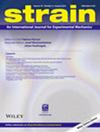Mechanical behaviour and fracture evolution of coal specimens containing an over‐excavated hole: Experimental study and numerical modelling
IF 1.8
3区 材料科学
Q2 MATERIALS SCIENCE, CHARACTERIZATION & TESTING
引用次数: 0
Abstract
Utilising a series of mechanically over‐excavated cavities along borehole is a novel technique for enhancing the permeability of soft coal seams and, consequently, gas drainage. The evolution of cracks induced by a wide range of pressure‐relief around an over‐excavated hole is intrinsically complex. In this study, the mechanical behaviour and crack evolution of the specimens containing an over‐excavated hole under uniaxial compression loading were studied by experimental and 3D numerical simulation. The results indicated that the peak strength and elastic modulus of the specimens gradually decrease with increasing cavity diameter and length, which is also verified by the numerical simulation. The inclusion of cylindrical cavities in over‐excavated holes results in reduced crack initiation stress and a greater degradation of peak stress and elastic modulus, despite having an equivalent volume to the ellipsoidal cavity. This is likely attributed to the difference in stress concentration between the cylindrical and ellipsoidal cavities. The crack propagation process can be classified into four stages based on the acoustic emission (AE) event counts, initial crack compaction, stable crack propagation, unstable crack propagation and post‐peak failure stage. The two AE indices, rise angle and average frequency value, demonstrated that the failure is dominated by tensile crack and gradually transformed to shear crack. Stress redistribution is essential in the initiation and propagation of cracks. Tensile stress concentration leads to cracks forming at the top and bottom of the hole, which propagate in the direction of loading. Compressive stress concentration results in shear cracks forming at the left and right sides of the hole, which propagate diagonally. The failure pattern of the specimen is ultimately determined by a combination of tensile and mixed crack propagation. The experimental and numerical results contribute to a deeper understanding of the crack evolution mechanism of coal seams with over‐excavated holes.含过开挖孔煤试样的力学行为和断裂演化:实验研究和数值模拟
利用一系列沿钻孔机械开挖的空腔是一种新技术,可以提高软煤层的渗透性,从而提高瓦斯抽采。过度开挖孔周围大范围的卸压引起的裂缝演化本质上是复杂的。通过实验和三维数值模拟,研究了单轴压缩荷载作用下含超开挖孔试件的力学行为和裂纹演化。结果表明,随着空腔直径和空腔长度的增加,试件的峰值强度和弹性模量逐渐降低,数值模拟结果也证实了这一点。在过度开挖的孔洞中包含圆柱形孔洞导致裂纹起裂应力降低,峰值应力和弹性模量的退化更大,尽管具有与椭球形孔洞相同的体积。这可能归因于圆柱形腔和椭球形腔之间应力集中的差异。根据声发射事件数,裂纹扩展过程可分为初始裂纹压实、稳定裂纹扩展、不稳定裂纹扩展和峰后破坏四个阶段。上升角和平均频率值两个声发射指标表明,破坏以拉伸裂纹为主,逐渐向剪切裂纹转变。应力重分布在裂纹的萌生和扩展过程中是必不可少的。拉应力集中导致孔顶和孔底形成裂纹,裂纹沿加载方向扩展。压应力集中导致在孔的左右两侧形成剪切裂纹,并沿对角线扩展。试样的破坏模式最终由拉伸和混合裂纹扩展的结合决定。实验和数值结果有助于深入理解过掘孔煤层的裂隙演化机制。
本文章由计算机程序翻译,如有差异,请以英文原文为准。
求助全文
约1分钟内获得全文
求助全文
来源期刊

Strain
工程技术-材料科学:表征与测试
CiteScore
4.10
自引率
4.80%
发文量
27
期刊介绍:
Strain is an international journal that contains contributions from leading-edge research on the measurement of the mechanical behaviour of structures and systems. Strain only accepts contributions with sufficient novelty in the design, implementation, and/or validation of experimental methodologies to characterize materials, structures, and systems; i.e. contributions that are limited to the application of established methodologies are outside of the scope of the journal. The journal includes papers from all engineering disciplines that deal with material behaviour and degradation under load, structural design and measurement techniques. Although the thrust of the journal is experimental, numerical simulations and validation are included in the coverage.
Strain welcomes papers that deal with novel work in the following areas:
experimental techniques
non-destructive evaluation techniques
numerical analysis, simulation and validation
residual stress measurement techniques
design of composite structures and components
impact behaviour of materials and structures
signal and image processing
transducer and sensor design
structural health monitoring
biomechanics
extreme environment
micro- and nano-scale testing method.
 求助内容:
求助内容: 应助结果提醒方式:
应助结果提醒方式:


